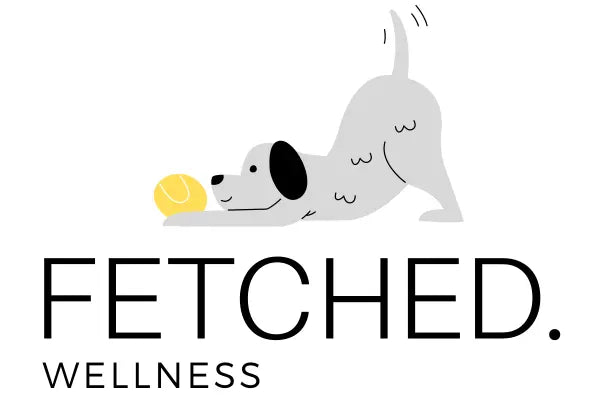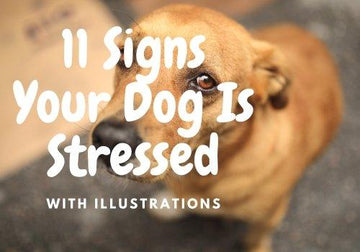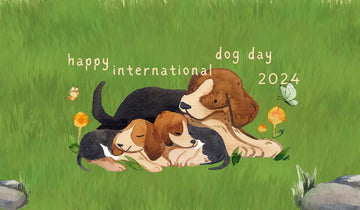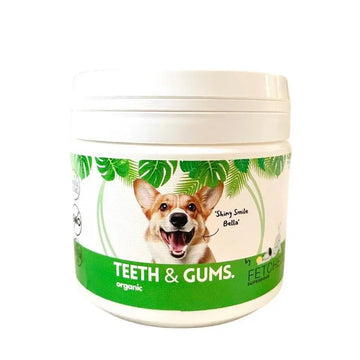Stress is everywhere these days, and it can affect animals, including your dog, as much as it can affect us humans. In fact, because of the bond your dog forms with you, you may even be passing some of your stress and anxiety over to your dog without even knowing it.
This process is called emotional contagion, and is believed to be specific to the link between doggos and humans. It can often happen for example in timid dogs who are exposed to strangers at home, as it can happen during parties or larger gatherings.
Table of Contents
- Excessive Grooming and Licking
- Increased Aggression or Fearfulness
- Excessive Pacing, Restlessness
- Dilated Pupils or Wide Eyes
- Drooling, frothing or yawning
- Barking or Howling
- Excessive Panting
- Pinned Low Ears
- Avoidance
- Shaking Off
- Low Tail Carriage
- Other Stress Indicators
- How can I treat stress in dogs?
So how can we recognise if our dog is quietly suffering from stress and anxiety?
Luckily, there are some telltale signs that you can use to spot stress and anxiety in a dog early on.
Let's take a deep dive at 11 indicators of signs of stress in dogs and what these may look like from a body language point of view.
Excessive Grooming and Lip Licking
Dogs groom themselves as part of their regular hygiene. However, stress can turn this normal behaviour into an obsessive one. You might notice your dog licking or grooming excessively, to the point where they may cause bald spots or sores on their skin.
You can think of this as the equivalent of excessive hair pulling in humans. This is caused trichotillomania and can also lead to bald spots.

This type of lip licking looks very different than when you feed your dog a spoonful of peanut butter and, like all of the signs, are usually accompanied or followed by other signs of stress listed below.
If your pet exhibits such excessive licking or grooming behavior, it's crucial to intervene early. Distraction techniques can help break the cycle of constant self grooming.

Increased Aggression or Fearfulness
Behavioral changes can often be the most apparent signs of stress in dogs. A typically relaxed and friendly dog might become irritable or aggressive when stressed or feeling threatened.
And can you blame them?
Alternatively, some dogs may display signs of fear, such as hiding under furniture, shaking or trembling, or showing hesitance in situations they were previously comfortable with.
Excessive Pacing, Restlessness
Restlessness in dogs is another physical sign of overwhelming stress. I'm not talking here about the usual playfulness or excitability you see in puppies or certain breeds or dogs more than others.
But pacing around the house, difficulty settling down, and repetitive behaviors such as circling can be signs of emotional distress.
While it's normal for dogs to have an active period, incessant movement, and signs of restlessness could be indicators of stress.
Dilated Pupils or Wide Eyes
If you notice your dog has dilated pupils or "whale eyes" that could be another sign of stress.
Whaled eye refers to when you can see the whites of the eyes on either side.
Drooling, frothing or yawning
Yawning in dogs has different meanings to yawning in humans. As our article on 105 pawsome dog facts tells us, it is not a sign of tiredness in dogs. It can be a sign of pacification, but very often it's also a sign of stress, especially when accompanied by drooling or excessive frothing.
Also called a "stress yawn" the yawning may happen with more intensity and may look away while doing it.

The dog may start yawning because they are not sure what they should do, so they may see it as a neutral action.
Barking or Howling

Vocalization such as barking or whining in dogs is also a common way of manifesting their stress and anxiety.
The idea is to look for any change from their baseline. Are they barking more? Do they act restless and whining more than usual for them?
Excessive Panting

Although panting can be normal in a tired or overheated dog, excessive panting in a dog is a sign of high stress levels and anxiety.
In this picture below, you will notice that the dog is uncomfortable with me being too close. It's not a hot day and she hasn't been running, therefore there is no reason for her to be panting. The other sign is that the ears are pinned back and low.

When a dog showing signs of stress suddenly stops panting and closes their mouth, that's a warning! Dogs often close their mouths shortly before they escalate to a snap or bite.

Pinned Low Ears
Dogs' ears vary greatly by breed. Some stand up, some hang low and some are artificially altered to achieve a specific look.
But no matter what type of ears your dog has, if they pin their ears back against their head, it could be a sign of stress.
Tara was a rescue dog and sometimes feels stress when socialising with people so she pulled her ears back, displaying that she was feeling anxious:

Remember to interpret this in context with other signs and the current situation.
Scruffy's ears are slightly pinned as well, but you can see from the rest of his body language that he is enjoying fetching the ball.

Avoidance
Avoidance can look like many things. Common types of avoidance include:
- Excessive sniffing
- Inattention
- Looking away
- Turning away
Basically, if your dog is in any way avoiding interacting with people or other dogs, he is showing you he is uncomfortable or the stress and anxiety levels are going up.

Lenny has had enough of the water and so is gently turning away to indicate this. Other dogs' displays can be even more obvious.
Avoidance means the dog wishes to discontinue the interaction. They are letting you know in the most polite way possible that they want you to stop what you are doing.
If your dog is avoiding interaction with anyone, human or canine, respect that choice. Don't force your dog to interact or carry on with something if they don't want to.
Shaking Off
Dogs will shake their bodies for various reason, whether they are wet or when they first wake up from a nap.
But stress-related shaking off almost always follows something the dog finds unpleasant. For example, many dogs shake off right after a veterinary exam.

My dog also shakes off after applying the anti flea drops to the base of his neck.
Low Tail Carriage
This is easier to see in some breeds of dogs, than others, obviously. It won't be as easy to spot in a dog that has a docked tail, for example.
Many people are familiar with the idea that a "tail between the legs" is a sign of fear, such as this:

But sometimes the tail gives less obvious signals and it may just be at a slightly lower angle than what is normal for your dog. This would also count as a sign of stress.
Other Stress Indicators

While the signs discussed are some of the most common, every dog is unique, and stress can manifest differently.
Other potential signs of high stress levels include:
- Destructive behavior such as digging in the garden or pulling
- Unexplained urination or defecation in the house,
- Tail wagging direction: Some experts and a recent study say that tail wagging to the right is a sign of a happy and relaxed dog, while wagging to the left could be a sign of stress and anxiety.
- other changes in dog body language such as a low body posture or weight shifted to back legs.
- Slow or tense movement
- Refusal of food, especially when your dog is a big foodie!
- Tension around eyes and mouth
- Inattentiveness to owner
- Sweating from paws (when it's not hot outside)
Take a look at the diagrams above for some of these illustrations.
The key is to watch out for any unusual behavior that doesn't align with your dog's usual way of acting.
This dog shows signs of extreme tension around the eyes and mouth. The mouth is closed, her ears are back and pupils are slightly dilated, taking into account the high amount of light in the room.

This is another dog showing signs of stress. The mouth is tense, pupils dilated with whale eyes and ears lowered. He is also looking just slightly away.

Not all dogs will exhibit all of these signs. The better you get at recognizing your dog's signs, the better you can help him or her avoid situations that could cause these kind of stressful problems.
Working with a qualified trainer or dog behaviourist can also help you learn how to help your dog form better associations in stressful environments.
Understanding Canine Body Language
As we have so far seen, a crucial aspect of identifying stress in dogs is understanding their body language. Dogs communicate a lot through their posture, tail position, ear orientation, and eye contact.
For instance, a dog with its tail tucked between its legs is not just showing submission, but could be indicating fear or anxiety.
Similarly, a dog that avoids direct eye contact or has a stiff body posture might be experiencing stress. It's all context dependent.
By becoming fluent in your dog's body language, you can more effectively recognize the early signs of stress and take timely action to alleviate your pet's discomfort. This proactive approach can foster a deeper bond between you and your canine friends, thus ensuring a happier, healthier family life.
How can I treat stress in dogs?
There are a lot of remedies you can try. Try to address the root cause of the stress and anxiety and this will often fix the problem.
For example if a timid dog gets stressed when there are too many people around, try to gradually introduce him to new people over a few weeks and months. Your dog can then start to understand how to act around bigger groups of people. Paying attention to what your dog is trying to tell you is very important.
Or is it separation anxiety from leaving your dog alone for too long causing all the problems? Loud noises such as from fireworks or from the road can also cause stress in dogs.
Regardless of the cause, you could try dog calming supplements or playing your dog some relaxing music when he encounters stressful situations.
A recent study from 2020 done in Finland found that 72.5% of dogs displayed anxiety-like behaviours, according to their owners. So don't despair if you think your dog is showing some of these signs of anxiety. If you pay attention to your dog's behaviour you should be able to find a remedy for the high stress or anxiety.
If still no luck with these conservative and natural remedies that you can try at home, the next step should be contacting your vet. Your vet's role will then be to rule out any more serious organic causes, and if so, then your dog could be referred to a dog behaviourist for further training.













